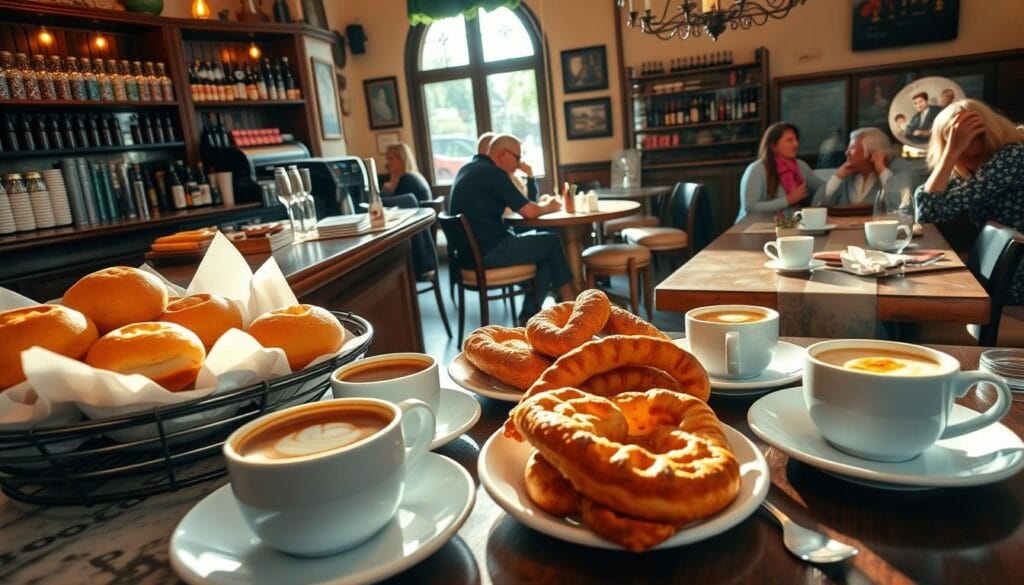As I sipped my morning espresso in Rome, the smell of pastries filled the air. This is the Italian breakfast, or “colazione,” a big part of their culture. It’s a journey that opens your taste buds and brings you closer to Italy’s heart.
Italian breakfasts are light and sweet, with coffee and pastries. You’ll find everything from cornetti (Italian croissants) to local treats like maritozzi con la panna in Rome. Each breakfast shows Italy’s rich food heritage. Enjoying your coffee and pastry, you’ll see it’s more than food—it’s a cultural start to your day.
Table of Contents
Understanding the Italian Breakfast Culture
Breakfast, or “colazione” in Italian, is a big part of daily life for Italians. It’s a time to start the day and connect with family and friends. Learning about Italian breakfast traditions can give us a peek into their cuisine and lifestyle.
The Meaning of “Colazione” in Italian Life
“Colazione” is more than a meal for Italians. It’s a tradition that marks the beginning of the day. It shows the importance of this morning’s time for Italians.
They see breakfast as a chance to come together, share moments, and get ready for the day ahead.
When and How Italians Have Breakfast
Italians usually have breakfast between 7 a.m. and 10:30 a.m. Most prefer a quick meal. This quick breakfast reflects the Italian value of being efficient and productive.
Many eat at home or stop by a local bar for a fast coffee and pastry. They enjoy their meal in just 10-15 minutes.
The Social Aspects of Morning Dining
Weekday breakfasts are often quiet, but weekends bring a social vibe. Families and friends enjoy their coffee and pastries, chatting and taking their time. This shows how much Italians value community and connections.
“Breakfast is a ritual in Italy, a time to reconnect with loved ones and start the day with purpose and joy.”
Coffee: The Heart of Italian Breakfast
Coffee is the star of the Italian breakfast. From espresso to cappuccino, these drinks are key to the Italian morning. Exploring Italian coffee traditions will excite your taste buds and take you to Rome or Milan.
Types of Morning Coffee Drinks
Italian breakfast offers many coffee choices. Here are some favorites:
- Caffè (Espresso): A strong coffee in a small cup.
- Caffè Doppio (Double Espresso): Two shots for more caffeine.
- Cappuccino: Espresso, steamed milk, and frothy foam.
- Caffè Macchiato: Espresso with a bit of foamed milk.
- Caffè Latte: Espresso and steamed milk in a tall drink.
- Latte Macchiato: Steamed milk with a shot of espresso.

The Rules of Ordering Coffee in Italy
Ordering coffee in Italy has its own rules. Remember, “latte” means milk, so ask for a “caffè latte” for coffee with milk. Also, milky coffee drinks are for mornings, while espresso is preferred later.
Why Size Matters in Italian Coffee Culture
In Italy, coffee size is important. Espresso cups are small, and cappuccinos are about 8 ounces. This shows the Italians’ love for coffee’s pure flavors.
“A true Italian breakfast is incomplete without the perfect cup of coffee, savored with care and respect for the tradition.”
Sweet Starts: The Traditional Italian Morning Pastries
Italians love their breakfast pastries. They enjoy flaky cornetti (Italian croissants) and soft bomboloni (Italian doughnuts). These treats are key to the Italian breakfast.
There’s more than just cornetti. Try the saccottino, a chocolate-filled pastry. Or the maritozzi, a sweet bun with whipped cream. They also have breakfast cookies like Gocciole and Pan di Stelle, and classic cakes and brioche.
Coffee is central to Italian breakfast, but these Italian breakfast pastries add soul. They come in many flavors and fillings. Enjoy them at a bar or bakery for a sweet start to your day.
“Until the 1970s, only one-third of Italians ate breakfast. In the early 1990s, an ‘Italian Breakfast’ campaign expanded the country’s mindset to include pastries.”
Tradition is key in Italian breakfasts. Pastries like biscotti from Prato, Tuscany, in the 14th century, are beloved. And who can resist Nutella-filled treats? These sweets are a big part of the Italian morning.
The Typical Italian Breakfast Experience at Bars
Enjoying breakfast at a local bar is a common experience in Italy. It’s a key part of the Italian breakfast traditions. It offers a quick and affordable way to start the day.
Standing vs. Sitting Culture
In Italy, it’s usual to stand at the counter for breakfast. This standing-room-only approach is the norm. It makes service faster and more efficient. But, if you want to sit, you’ll pay more for the comfort.
Price Points and Etiquette
Breakfast at an Italian bar is very cheap. A coffee and a traditional Italian morning meal pastry cost just a few euros. The bars focus on quick service, so you’ll pay and leave fast to make room for others.
Best Times to Visit Italian Bars
The best time to visit an Italian bar for breakfast is early. Around 6 to 9 AM, the pastries are fresh, and the place is lively. You’ll get to see the Italian breakfast traditions of the local crowd.

Whether standing or sitting, trying the traditional Italian morning meal at an Italian bar is a must. It’s a great way for visitors to dive into Italy’s vibrant culinary culture.
Regional Breakfast Specialties Across Italy
Italian breakfasts often include a sweet pastry and strong coffee. But each region in Italy has its special breakfast treats. In Sicily, you’ll find creamy granita and soft brioche. Naples is famous for its tagliatelle, a pastry filled with ricotta.
In Rome, don’t miss the maritozzi con la panna, a sweet roll with whipped cream. In Campania, the tagliatelle is a must-try. It’s a shell-shaped pastry with a flaky outside and creamy inside. Sicily offers a refreshing start with granita and brioche.
Sardinia is home to fatti fritti, large fried pastries. In Puglia, Lecce is known for its pasticciotti, small tarts filled with custard. These are perfect for breakfast.
Whether you like flaky pastries or fruity granitas, Italy’s breakfasts are a treat. Exploring these specialties lets you dive into Italy’s rich culinary traditions.
| Region | Breakfast Specialty |
|---|---|
| Rome | Maritozzi con la panna (sweet rolls filled with whipped cream) |
| Campania | Sfogliatelle (shell-shaped pastries with ricotta filling) |
| Sicily | Granita (creamy fruit-based icy treat) with brioche |
| Sardinia | Fatti fritti (large, fried pastries) |
| Puglia | Pasticciotti (small custard tarts) |
Hotel Breakfast vs. Local Experience
Choosing where to have breakfast in Italy can change your experience. Big chain hotels offer big breakfast buffets. They have sweet and savory dishes for everyone. But, it’s not as real as the Italian breakfast cuisine.
Staying at a family-run hotel or agriturismo is different. They serve local pastries, homemade cakes, and fresh fruits. This gives you a true taste of the region’s food.
What to Expect at Different Accommodations
- Chain hotels: Expansive buffets with a mix of international and Italian breakfast items
- Family-run hotels: Locally sourced pastries, homemade baked goods, and regional specialties
- Agriturismos: Farm-fresh products, including eggs, cheeses, and seasonal produce
- B&Bs: The most authentic Italian breakfast experience, with a focus on traditional recipes and local ingredients
Breakfast Buffet Options
Hotel breakfast buffets are convenient but lack a personal touch. The typical Italian breakfast is simple. It focuses on quality over quantity.
Authentic vs. Tourist-Oriented Offerings
To experience an Italian breakfast, go beyond hotels. Visit local cafes, bars, and bakeries. They offer traditional pastries, coffee, and a relaxed vibe.
Sweet Spreads and Breakfast Breads
Exploring the traditional Italian breakfast means diving into sweet spreads and fresh breads. At its core is Nutella, a creamy mix of chocolate and hazelnut. It’s a favorite in Italy, enjoyed on its own or warm fette biscotti (crisp, twice-baked toast).
Jams and honey are so added to the traditional Italian morning meal. They pair well with freshly baked breads, a key part of Italian breakfast. From flaky cornetti (Italian croissants) to soft bomboloni (Italian-style doughnuts), these pastries are enhanced by a drizzle of honey or jam.
Italians prefer fresh, local bread over packaged ones. This shows their love for quality and authenticity. Whether it’s a crusty loaf from the panetteria (bakery) or a soft panettone, these breads are perfect for the sweet spreads that make breakfast special.
“The key to a perfect Italian breakfast is the perfect balance of sweet and savory, with the freshest breads and the most indulgent spreads.”
The Role of Seasonal Fruits and Yogurt
Italian breakfast culture is changing, with a focus on healthy options. Seasonal fruits and yogurt are now favorites, especially for those who care about their health. Fresh fruits, often from local farms, are added to traditional breakfasts. They can be enjoyed alone or as toppings for pastries.
Modern Healthy Alternatives
Yogurt is becoming a big hit for breakfast in Italy. It’s packed with protein and good for your gut. People love it plain or with honey, fruits, or nuts.
Traditional Fruit Preparations
- In places like Sicily, granita (a semi-frozen dessert) is a long-time breakfast favorite.
- Other beloved dishes include Macedonia (a fruit salad) and frutta di stagione (seasonal fruits).
Adding seasonal fruits and yogurt to breakfast shows Italy’s shift towards health. Yet, it still keeps the heart of the classic Italian breakfast.

Common Myths About Italian Breakfast
Many people think that a typical Italian breakfast includes big, savory meals with eggs and bacon. But, this is not true. These foods are not common in Italian breakfasts.
Another myth is that all Italians have big, sit-down breakfasts every day. But, many Italians prefer quick, simple meals. The Italian breakfast traditions are quite varied.
- Italians do not typically eat large, savory breakfasts with eggs, bacon, and other protein-heavy foods.
- Not all Italians have an elaborate, sit-down breakfast experience every morning; many prefer quick, simple meals.
- The Italian breakfast traditions are more varied than the popular perceptions.
“Contrary to popular belief, Italians don’t typically eat large, savory breakfasts. Eggs, bacon, and other protein-heavy foods are not common breakfast items.”
Learning about typical Italian breakfast customs can clear up these myths. It shows the variety of breakfast habits in Italy. By exploring Italian breakfast traditions, we can see the richness of Italian culinary culture.
Tips for Enjoying Breakfast Like a Local
Enjoying Italian breakfast cuisine like a local is all about embracing the traditional Italian morning meal. Dive into the lively breakfast culture that’s a big part of daily life in Italy.
Start by standing at the bar for a quick coffee and pastry. This is the real Italian breakfast experience. You can sip your espresso or cappuccino while chatting with locals. Remember, cappuccinos are for mornings only, as Italians prefer them before 11 am.
Don’t shy away from the sweet breakfast treats Italians love. Cornetti (croissants), bomboloni, and maritozzo are just a few favorites. These pastries are the heart of the traditional Italian morning meal. Save the savory dishes for later, as breakfast is light and sweet.
Explore regional breakfast specialties as you travel to Italy. Each region has its breakfast traditions. Enjoy the local tastes and discover the variety of Italian breakfast cuisine. Remember, breakfast is quick and casual, so save room for lunch and dinner.
“The secret to enjoying breakfast like a local in Italy is to embrace the simplicity and ritual of the morning meal.”
Follow these tips to enjoy the traditional Italian morning meal like a local. Savor the taste, enjoy the atmosphere, and take part in the daily ritual that’s so important in Italian culture.
Conclusion
The typical Italian breakfast is a joy to experience. It shows off the country’s love for good food and social time. Quality coffee and sweet pastries are key, along with the chance to connect with others.
Enjoying a flaky croissant with strong espresso or a Pasticciotto Leccese is a must. It makes your trip even better. Learning about Italian breakfast foods and customs lets you live like a local.
When you visit Italy next, try the different breakfasts each region offers. Don’t miss the fresh fruits and yogurt. An Italian breakfast is more than food; it’s a way to appreciate Italy’s rich food culture.
FAQ
What is the typical Italian breakfast?
When and how do Italians have their breakfast?
What is the role of coffee in an Italian breakfast?
What are some traditional Italian breakfast pastries?
What is the typical breakfast experience at Italian bars?
Are there any regional breakfast specialties in Italy?
How do hotel breakfasts in Italy differ from local experiences?
What are some common Italian breakfast condiments and breads?
How are seasonal fruits and yogurt incorporated into Italian breakfast?
Are there any myths about Italian breakfast?
Have you tried our Recipe ?
There are no reviews yet. Be the first one to write one.


1 thought on “Typical Italian Breakfast: Simple, Sweet, and Delicious”
Comments are closed.